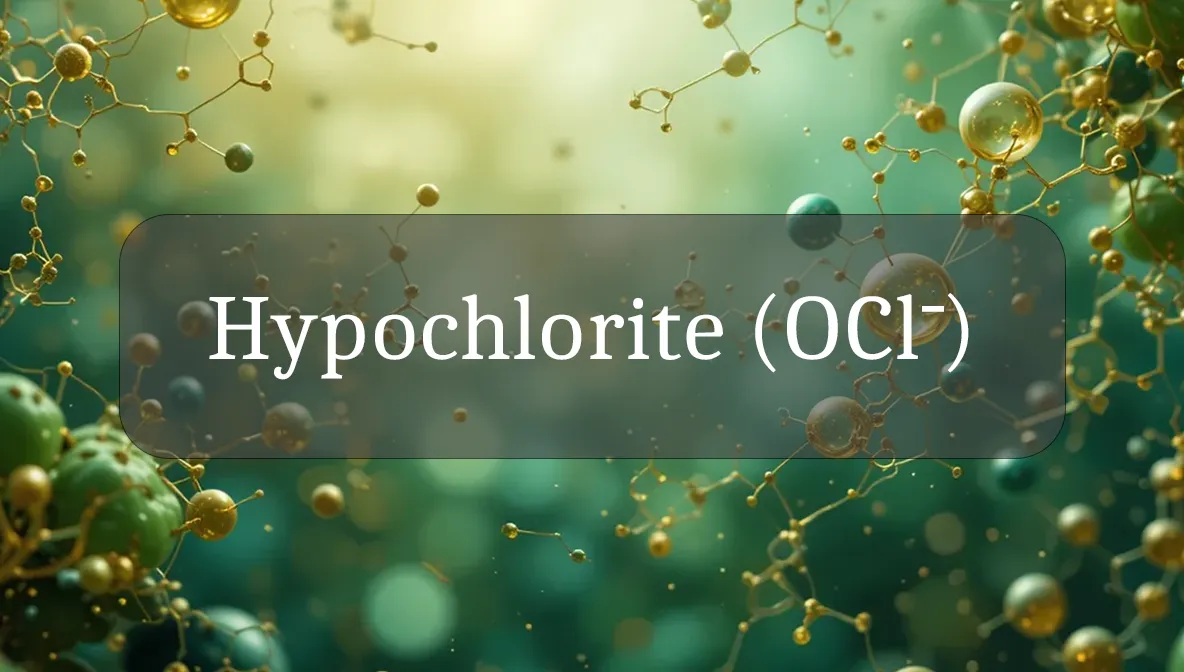Powerful Molecule for a Healthier Environment
Hypochlorite (OCl⁻) might sound like a chemistry lab term, but it’s a hardworking molecule you encounter daily in bleach, water treatment, and even pool maintenance. While it’s not something you consume, hypochlorite plays a big role in keeping your surroundings safe, which supports your overall wellness. Let’s dive into what hypochlorite is, why it matters for health, and how to use it wisely for a cleaner, healthier life.
Chemical Identity and Type
Hypochlorite (OCl⁻) is a molecule made of one oxygen atom bonded to one chlorine atom, carrying a negative charge. It’s a cation (a negatively charged ion) and a potent oxidizing agent, meaning it can destroy harmful substances like bacteria or organic matter. You’ll find hypochlorite in sodium hypochlorite (household bleach) and disinfectants, where its reactive power makes it a top choice for killing germs. It’s not a nutrient, but its role in hygiene is key to health.
Biological Role and Benefits
Hypochlorite doesn’t work directly in your body like vitamins or minerals, but it supports wellness by keeping your environment clean and safe:
- Germ-Killing Power: Hypochlorite in bleach or disinfectants wipes out bacteria, viruses, and fungi, reducing your risk of infections from contaminated surfaces, food, or water.
- Safe Drinking Water: In water treatment, hypochlorite eliminates harmful microbes, ensuring the water you drink supports hydration and overall health without risky pathogens.
- Wound Care (Special Cases): In diluted forms (like Dakin’s solution), hypochlorite is used medically to clean wounds, preventing infections and aiding healing under professional supervision.
By reducing germ exposure, hypochlorite indirectly supports your immune system, helping you stay healthy.
Dietary or Natural Sources
Hypochlorite isn’t a nutrient you eat or drink, but it’s present in your environment in these forms:
- Household Cleaners: Sodium hypochlorite is the active ingredient in most bleaches (3–6% concentration), disinfecting wipes, sprays, and laundry sanitizers.
- Water Purification: Trace amounts of hypochlorite are added to municipal drinking water or portable purification tablets to kill microbes. These levels are safe for consumption.
- Pool and Spa Sanitizers: Hypochlorite (or compounds like calcium hypochlorite) keeps swimming pools and hot tubs free of bacteria and algae.
- Medical Solutions: Diluted hypochlorite solutions (e.g., 0.025% for wound care) are used in clinical settings but aren’t dietary sources.
Hypochlorite’s role is external, keeping your surroundings safe rather than nourishing your body directly.
Signs of Imbalance or Dysfunction
Since hypochlorite isn’t part of your body’s natural chemistry, “imbalance” refers to improper use or exposure rather than a biological deficiency or excess:
- Overexposure to Hypochlorite:
- Symptoms: Skin redness, itching, or burns; eye irritation; coughing or throat discomfort; nausea from inhaling fumes.
- Causes: Misusing bleach (e.g., mixing with ammonia, creating toxic chloramine gas), overusing disinfectants, or exposure to high chlorine levels in pools.
- Impact: Can cause skin, eye, or lung irritation; severe cases may lead to chemical burns or breathing issues.
- Underexposure (Rare):
- Symptoms: Increased risk of infections from unsanitized water or surfaces.
- Causes: Lack of proper hygiene or access to clean water.
- Impact: Higher chance of waterborne illnesses like diarrhea or skin infections.
Using hypochlorite correctly prevents these risks while maximizing its benefits.
Supporting Optimal Levels or Function
Since hypochlorite is an external substance, the focus is on using it safely to maintain a healthy environment:
- Dilute Bleach Properly: For surface cleaning, mix 1 tablespoon of household bleach per gallon of water (or follow product guidelines) to disinfect effectively without excess exposure.
- Ensure Safe Water: Drink treated municipal water or use purification tablets when traveling to areas with unsafe water sources to avoid pathogens.
- Ventilate During Use: Clean with hypochlorite products in well-ventilated spaces to avoid inhaling fumes. Wear gloves to protect your skin.
- Check Pool Maintenance: Ensure swimming pools are treated with appropriate hypochlorite levels to prevent infections without causing irritation from overuse.
- Use Sparingly: Over-disinfecting can lead to unnecessary exposure. A small amount of hypochlorite is enough to kill germs effectively.
These habits let hypochlorite support your health without causing harm.
Safety, Interactions, and Precautions
Hypochlorite is highly effective but demands careful use to avoid risks:
- Avoid Dangerous Mixes: Never combine bleach (sodium hypochlorite) with ammonia, vinegar, or other cleaners, as this can produce toxic gases like chloramine or chlorine gas.
- Protect Skin and Eyes: Wear gloves and avoid splashing hypochlorite solutions. Rinse immediately if it contacts skin or eyes.
- Inhalation Risks: Use hypochlorite in well-ventilated areas. Fumes can irritate lungs, especially for those with asthma or respiratory conditions.
- Safe Storage: Keep hypochlorite products in cool, dry places, out of reach of children and pets. Diluted solutions lose strength quickly, so mix fresh as needed.
- Medical Considerations: If you have sensitive skin, allergies, or lung issues, use hypochlorite cautiously and consult a doctor if irritation occurs.
- Environmental Caution: Excess hypochlorite runoff can harm aquatic life. Dispose of solutions responsibly per local guidelines.
Fun Fact
Did you know that hypochlorite is behind the classic “pool smell”? That scent isn’t just hypochlorite—it’s actually chloramines, formed when hypochlorite reacts with sweat or urine in pool water. A well-maintained pool with proper hypochlorite levels should have almost no smell!
Citations
- Centers for Disease Control and Prevention (CDC). (2023). Chemical Disinfectants: Guidelines for Disinfection and Sterilization.
- World Health Organization (WHO). (2022). Guidelines for Drinking-Water Quality.
- Mayo Clinic. (2024). Chemical Burns: First Aid.
- Environmental Protection Agency (EPA). (2023). Sodium Hypochlorite: Uses and Safety.
- National Institutes of Health (NIH). (2023). Wound Care and Antiseptics.

